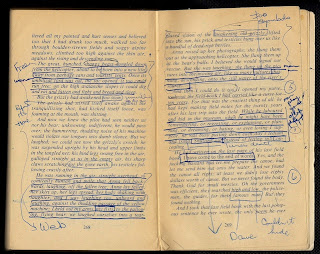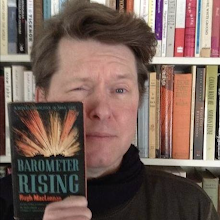Mark it for Murder
Douglas Sanderson
New York: Avon, [1959]
Douglas Sanderson had left Montreal behind as both a home and a setting when Mark it for Murder was published, but traces of the city remain. Just look at John Molson, the name of our hero. We're told next to nothing about this man, except that he once studied at the Sorbonne. Europeans take him for an American, but I wouldn't be so sure.
The opening pages of
Mark it for Murder find Molson at a private club on the French Riviera. He gets plastered with a Swede, makes love on the beach with beautiful Julie Chirac and pummels her escort Roger Lascelles before being called away to attend to Joseph P. Craddock, his wealthy employer. On the way back the Mercedes Molson drives loses a wheel and careens off a cliff into the Mediterranean. He bails, rescuing Louise (another love interest) in the process.
Stripped to its bare bones, the beginning of the novel sounds rather silly, but it's actually very strong.
Mark it for Murder features some of Sanderson's finest writing, particularly in its sketches of Spain:
So up and down they walk, making talk as adolescents make drawings on a lavatory wall. From the same motive and with the same innocence. I listened. Spaniards talk so loudly it is difficult not to listen. They were describing as true the things imagined before falling asleep the previous night. But their lies were gracious, interesting and enthusiastic. They enjoyed what they were saying and politely hid their disbelief in another man's story.
The change in location comes courtesy of Craddock. An aged blackmailing businessman who has found religion, he's by far the most realized and intelligent character in the novel. Craddock's violent death, depicted on the cover of
Cry Wolfram, the Secker & Warwick edition, marks an unfortunate downturn.
Craddock really knew the ins and outs of the extortion business; now that he's no longer around to explain the novel becomes a confusing mess. Things get so bad that by the third to last chapter, Sanderson resorts to a sit-down with a chatty, campy, faux-English queen who happily answers any and all questions that Molson cares to pose. This is followed by a chapter in which all the key players gather in a room to hear out the accusations and theories of the local governor. And finally – in the final chapter – an attempt at a denouement as Molson and Louise take in a bullfight.
A frustrating book, it features a surprise ending with Molson losing Louise to a matador on the final page. I'm not sure why, but I'm sure Craddock could've explained it... or maybe the chatty, campy, faux-English queen.
Object: A fragile 160-page mass market paperback. Though labeled "An Avon Original", it looks to have been preceeded by
Cry Wolfram, Secker & Warburg's UK first. Both editions enjoyed just a single printing each.
Access: Canadian library patrons will find
Mark it for Murder at Concordia University and Library and Archives Canada. The University of Calgary and University of Victoria have
Cry Wolfram.
Curiously,
Cry Wolfram appears to be more common than
Mark it for Murder. Seven copies of the former are listed online – all with dust jackets – at prices ranging from eight to thirty dollars. Very Good plus copies of
Mark it for Murder can be had for between four and eighteen dollars. But hurry – only four copies are listed online.
A French translation using under Sanderson's Martin Brett pseudonym was published by Gallimard. Title:
La semaine de bonté.
Not to be confused with Max Ernst's
Une semaine de bonté.




















